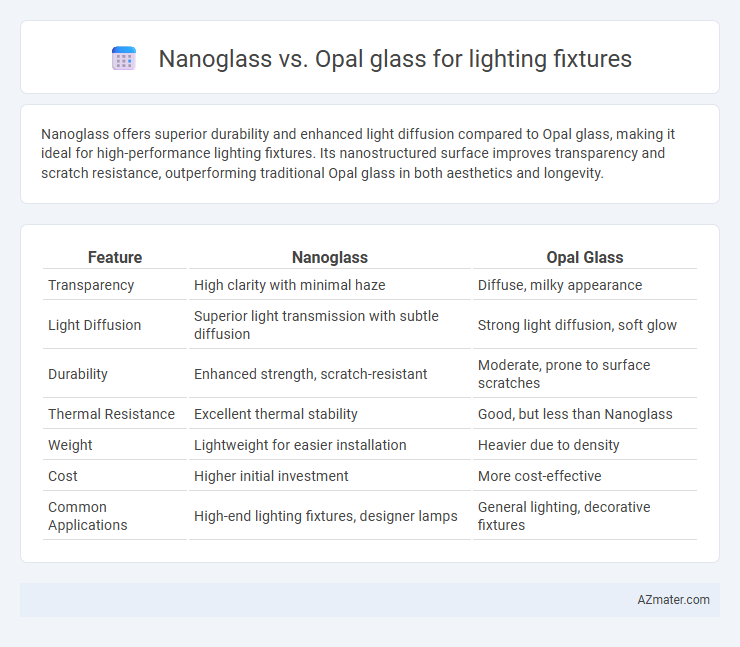Nanoglass offers superior durability and enhanced light diffusion compared to Opal glass, making it ideal for high-performance lighting fixtures. Its nanostructured surface improves transparency and scratch resistance, outperforming traditional Opal glass in both aesthetics and longevity.
Table of Comparison
| Feature | Nanoglass | Opal Glass |
|---|---|---|
| Transparency | High clarity with minimal haze | Diffuse, milky appearance |
| Light Diffusion | Superior light transmission with subtle diffusion | Strong light diffusion, soft glow |
| Durability | Enhanced strength, scratch-resistant | Moderate, prone to surface scratches |
| Thermal Resistance | Excellent thermal stability | Good, but less than Nanoglass |
| Weight | Lightweight for easier installation | Heavier due to density |
| Cost | Higher initial investment | More cost-effective |
| Common Applications | High-end lighting fixtures, designer lamps | General lighting, decorative fixtures |
Introduction to Nanoglass and Opal Glass in Lighting Fixtures
Nanoglass for lighting fixtures offers enhanced durability and superior light diffusion, utilizing nanotechnology to achieve a smoother surface and increased transparency compared to traditional materials. Opal glass, characterized by its milky white, translucent appearance, provides soft, uniform illumination that reduces glare and creates a cozy ambiance. Both materials serve distinct purposes in lighting design, with nanoglass excelling in strength and clarity while opal glass is favored for its classic diffuseness and aesthetic warmth.
Material Composition: Nanoglass vs Opal Glass
Nanoglass is composed of ultrafine glass particles that create a smooth, transparent surface with enhanced durability and resistance to scratches and thermal stress. Opal glass contains a high concentration of silica combined with opacifiers like tin oxide or titanium dioxide, resulting in a milky, diffused light effect ideal for soft illumination. The difference in material composition impacts optical clarity, strength, and light diffusion properties critical for lighting fixture performance.
Optical Properties and Light Diffusion
Nanoglass and opal glass differ significantly in their optical properties and light diffusion capabilities for lighting fixtures. Nanoglass offers superior clarity and higher light transmittance, enhancing brightness while maintaining efficient light diffusion through its nanoscale surface structure. Opal glass provides more uniform, softer light diffusion due to its milky translucency, reducing glare and creating a diffused ambient glow ideal for comfortable lighting environments.
Durability and Longevity Comparison
Nanoglass offers superior durability for lighting fixtures due to its enhanced resistance to scratches, impacts, and thermal stresses compared to opal glass. Opal glass, while providing excellent light diffusion, tends to be more prone to chipping and breakage over time under harsh conditions. The longevity of nanoglass fixtures generally surpasses opal glass, making nanoglass a preferred choice for environments demanding robust and long-lasting lighting solutions.
Aesthetic Differences for Interior Design
Nanoglass offers a sleek, modern aesthetic with a smooth, almost translucent surface that diffuses light softly, enhancing contemporary interior designs with a subtle glow. Opal glass, characterized by its milky, opaque finish, creates a classic, warm ambiance by evenly scattering light and reducing glare, making it ideal for traditional or cozy spaces. Designers often choose nanoglass for minimalist, high-tech lighting fixtures, while opal glass suits vintage or rustic interiors where a softer, diffused illumination is preferred.
Maintenance and Cleaning Requirements
Nanoglass lighting fixtures offer superior resistance to fingerprints and smudges compared to Opal glass, reducing the frequency of cleaning needed. Opal glass surfaces are more prone to visible dust and grime buildup, requiring more regular maintenance to maintain clarity and brightness. Nanoglass's durable, non-porous surface simplifies cleaning with mild agents, while Opal glass often demands gentler handling to avoid scratching or clouding over time.
Energy Efficiency and Light Output
Nanoglass offers superior energy efficiency compared to Opal glass by enhancing light transmission and reducing energy loss in lighting fixtures. The advanced nanostructure of Nanoglass allows for higher light output with lower wattage, making it ideal for sustainable and cost-effective lighting solutions. Opal glass, while providing uniform light diffusion, typically absorbs more energy, resulting in slightly lower luminous efficacy than Nanoglass.
Cost Analysis: Initial Investment and Lifespan Value
Nanoglass lighting fixtures typically require a higher initial investment compared to Opal glass due to advanced manufacturing processes and enhanced durability. Despite the upfront cost, Nanoglass offers superior lifespan value by resisting scratches and yellowing, reducing replacement frequency and maintenance expenses. Opal glass, while more affordable upfront, may incur higher long-term costs due to its shorter lifespan and susceptibility to wear, making Nanoglass a cost-efficient choice for sustained use.
Environmental Impact and Sustainability
Nanoglass offers superior environmental benefits over Opal glass in lighting fixtures due to its enhanced durability and reduced energy consumption during production, resulting in lower carbon emissions. Opal glass, while recyclable, typically requires higher energy input in manufacturing and has a shorter lifespan, leading to increased waste and environmental burden. Choosing Nanoglass contributes to sustainability goals by minimizing resource use, enhancing recyclability, and extending the fixture's lifecycle.
Choosing the Right Glass for Your Lighting Needs
Nanoglass offers superior clarity and durability, making it ideal for modern lighting fixtures that require high light transmission and scratch resistance. Opal glass provides a soft, diffused glow that reduces glare and enhances ambient lighting, perfect for creating warm, inviting spaces. Selecting Nanoglass maximizes brightness and longevity, while Opal glass prioritizes a cozy atmosphere and gentle illumination.

Infographic: Nanoglass vs Opal glass for Lighting fixture
 azmater.com
azmater.com